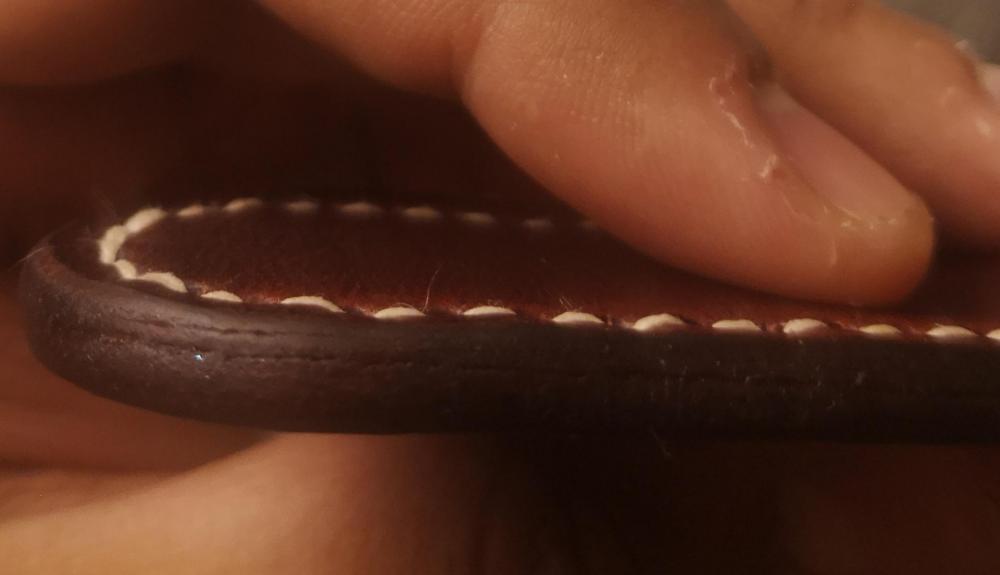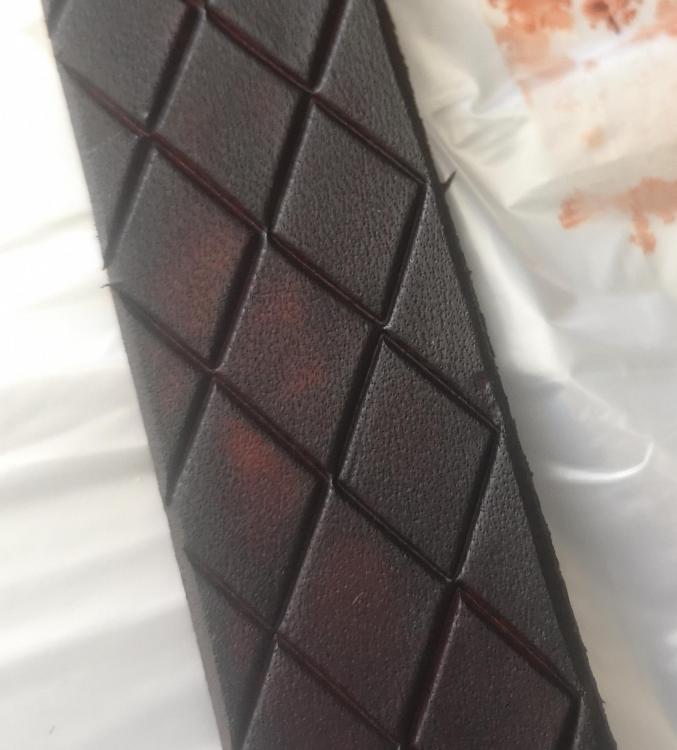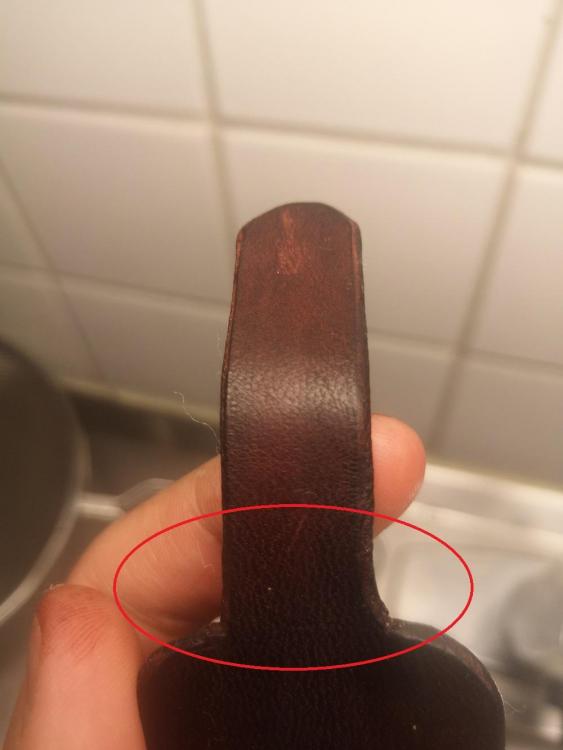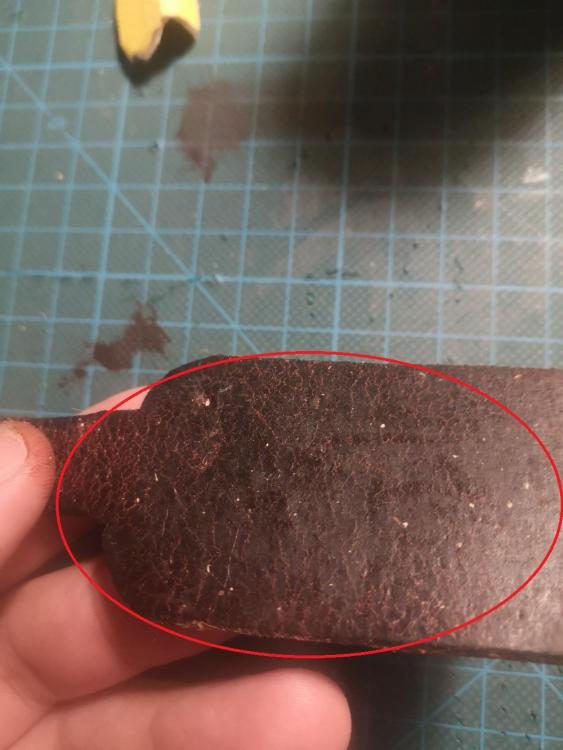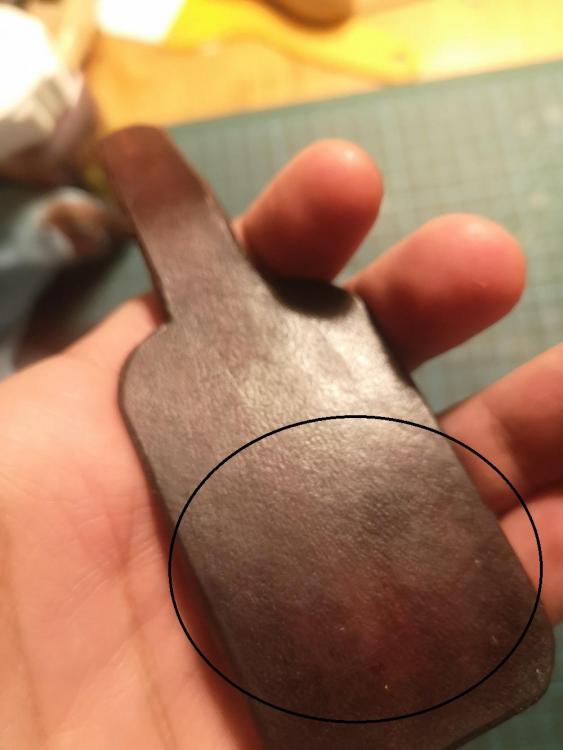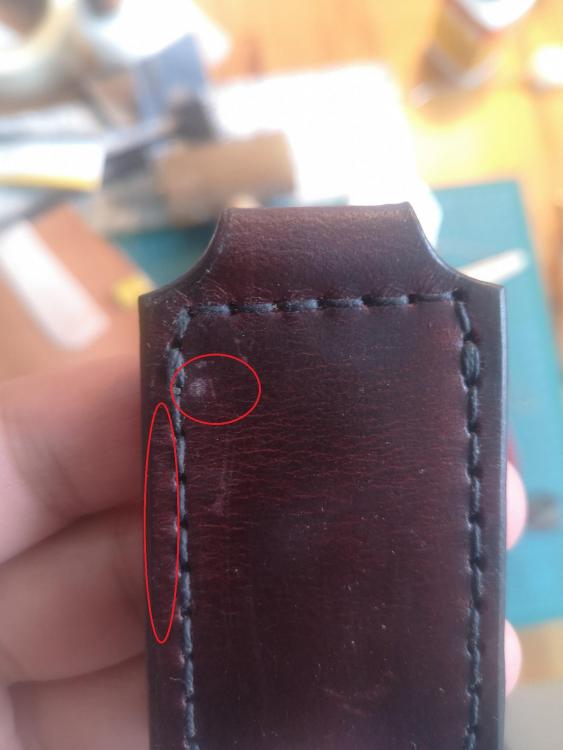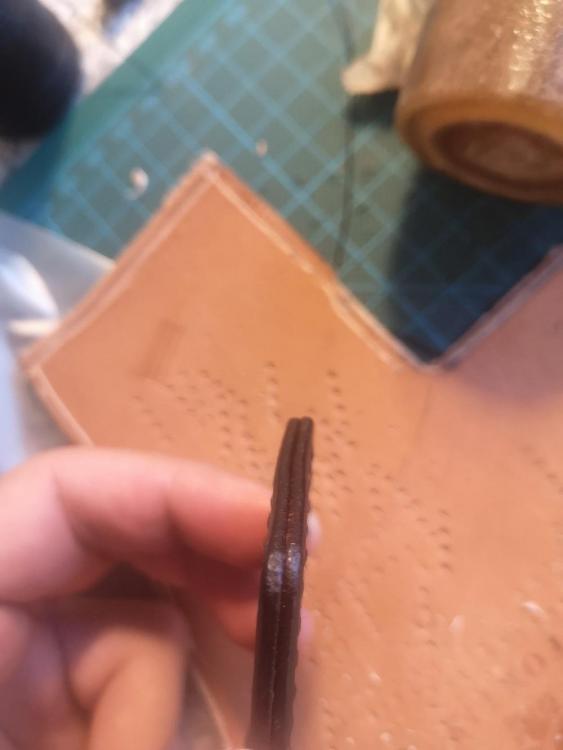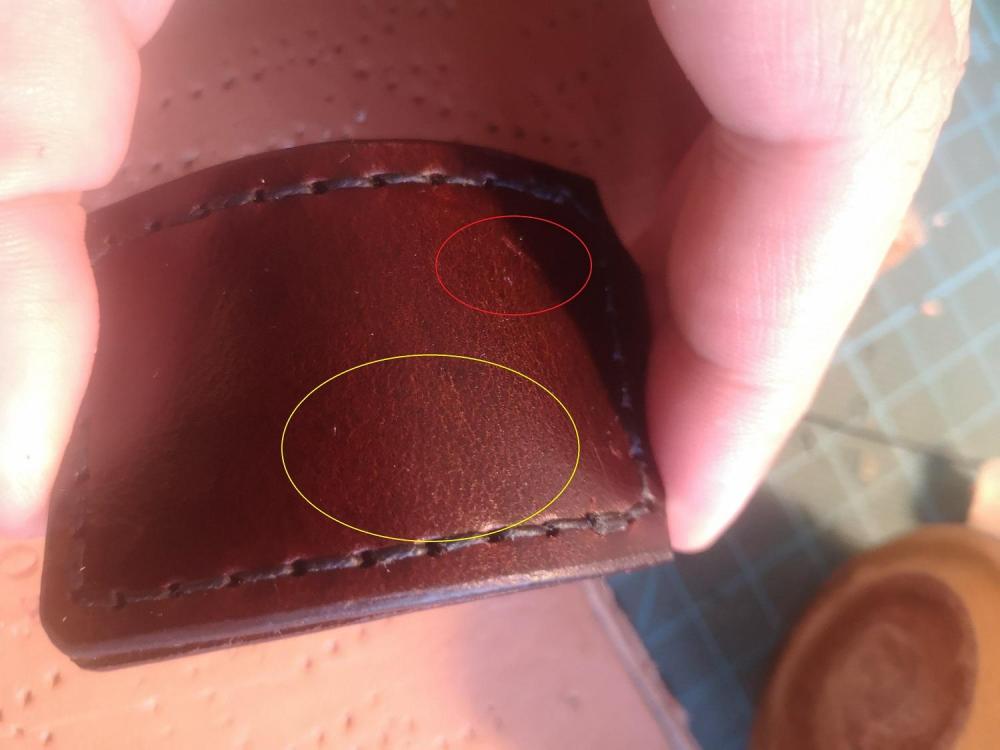
LionCrownLeather
Members-
Posts
40 -
Joined
-
Last visited
Content Type
Profiles
Forums
Events
Blogs
Gallery
Everything posted by LionCrownLeather
-
I do glue but I only let it dry two hours and I dont hammer the glued area, i am a bit afraid of hammering because everytime I hammer my stichting my veg tanned leather gets damages, I have seen people use a piece of leather on the project to hammer on but that is a different topic.. I dont add any weight on the glue no :/
-
Ofcourse, i always glue both pieces together.
-
Hello all, I have been improving the edges of my projects lately but I am having trouble making both sides of the project which are sewn together look like one piece. Imagine two pieces of leather that you want to sew together. I want the edges to look clean. I always sandpaper and make sure the edges match, but the problem is that depending on how much I sandpaper the leather tends to fold a bit at the edge, mostly the flesh side of the leather. This create an uneven line when the two pieces are sewn together. Maybe this is normal and is usually invisible if enough amount of dye and burnishing is applied? Maybe you cut the extra fibres off from the flesh side with a sharp razor after having used sandpaper? See images attached. The line is not in the middle when the project is sewn together and it makes the edge look unprofessional. Maybe its because I should bevel both sides of the project? I cut the project out of a piece of leather, bevel edges, sandpaper, bevel again, check the edges, if unsmooth I will sandpaper more, dip dye, glue together, use a wing divider to mark line, make holes with chisel, hand stich, apply edge paint, apply tekonole and burnish.
-
Questions about leathercraft
LionCrownLeather replied to LionCrownLeather's topic in How Do I Do That?
I can only imagine how much easier it would be to actually just press out the shapes you want instead of cutting. How about the templates you put in the machine, do you buy them online? I live in Europe. Maybe there are sellers online who can make customized ones. Any press machine type you have in mind which you can recommend? My go to is mainly card holders, key chains and eventually larger projects in the future. -
Hi I always use Tokonole on the flesh side after having dip dyed my piece using pro oil dye. Problem is that if parts of it comes on the front side it will leave waxy stains and darken, basically ruining the front of the project. Also if you have small leather grains laying around on your workspace and you use Tokonole it will get glued in to the project as well. Should I skip using Tokonole? For edges I have to say Tokonole does its job, its great for edges but maintaining it so that it doesn't end up on the front side is tricky. Solution that I see here is to use Tokonole before dyeing but I have heard that it will close the leather fibers and prevent the leather from absorbing any dye.
-
Questions about leathercraft
LionCrownLeather replied to LionCrownLeather's topic in How Do I Do That?
Regarding the leather I just collected. I noticed even when dyed and after a layer of top coat is put on the leather can still bend/reshape? I can shape this leather.. If I am not mistaken this leather is used for knife sheets and other harder projects where you want to bend something and keep that shape? If I want to soften it how do I do that? I think I just collected leather that I cant use for keychains.. What kind of projects do you think this leather is good for? -
Questions about leathercraft
LionCrownLeather replied to LionCrownLeather's topic in How Do I Do That?
Hi Thank you for the reply, really helpful I am so happy internet exists and I can learn from you all. Yes, I forgot to glue... Where I live leather is not a big market, there are few companies here which sell skins and leather tools, for my first projects I did not want to put too much money into it and buy several square feet leather, instead I just bought some leather scraps to start with. Most of the scraps were different and I just determined by the color that it is veg tanned leather and bought it. Regarding the stitching lines, I think the thread is too thick, I used 5 mm holes which I also think is maybe too big for this small piece, maybe 3-4 mm pricking iron would be ideal but its a taste thing as you say, generally I like neat "clean" looks more. Now I just collected 2.5 mm 12 square ft piece of leather and I was going to cut out a template I have for my keychain and it did not go so well. How do you cut this kind of leather? What do you cut with and most importantly how do you cut rounded edges? My knife is very sharp but when it comes to round edges it is extremely difficult to be consistent, the blade sometimes suddenly goes into an angle and cuts the flesh side more. Thank you -
Questions about leathercraft
LionCrownLeather replied to LionCrownLeather's topic in How Do I Do That?
Hi Thank you for the reply, What is a handpress purpose and what is a "die"? Today I was cutting a 2.5 mm new piece of veg tanned leather and I could not at the corners of my template. With a roller it worked to cut straight lines perfectly but as soon as I reached the edges I changed to a knife and it is much harder than it looks. How do you usually cut the edges? I think that the most difficult part and most time consuming is to cut out the templates I use.. Now with this 2.5 mm leather which is quite stiff I find this part extremely difficult to cut. I have bought a quite expensive veg tanned piece of leather that I was going to use for key chains but now that cutting the template seems to be that difficult I want your suggestions. Also please reply back on what kind of leather you think I used before for my first keychain (pictures above) its a soft leather compared to the stiff one I have now which is very "grainy?". It was much easier to work with but I did not like the fact that it became lighter when stretched. -
Questions about leathercraft
LionCrownLeather replied to LionCrownLeather's topic in How Do I Do That?
I accidentally burned a spot when trying to burn a piece of thread. I wonder if this is not suede leather? It seems that every time i touch the key chain it gets stretched out ... -
Questions about leathercraft
LionCrownLeather replied to LionCrownLeather's topic in How Do I Do That?
Adding some information: I burnished the key chain when the two pieces were stitched together and got a slightly better result for the edges. -
Hi I just started working on some leather projects where I design and complete projects by myself. I have a key chain that I made and I wanted your professional opinions. The leather I used for this typical project changes color when folded, what do you call this type of leather? What projects do you recommend using this kind of leather for? Now I did not have any other type of leather laying around but I feel like this does not give a consistent look if sold in higher quantities on the Internet because when I was finished with the project I noticed some parts were lighter than others, probably because I folded the final result a bit during hand stitching. I have attached some images and I would be glad to hear what I can do better, also below is the step by step on how I did, is there anything here you would do differently? Step by step on how I made the key chain: I used my template and cut the piece I wanted ( I don't have a go to method for corners and I find it quite difficult to get it completely round, how do you do here? ) I punched the leather with a 5 mm pricking Iron ( I use the pricking Iron because it gives me the consistent result I am looking for compared to the diamond chisel which I find harder to work with ). Beveling I dyed using pro oil dye (mahogny) twice with 30 min before each layer to get a darker look Used a piece of cloth to rub off I finished the edges with sandpaper ( It turned out that the sides absorb much dye and there for I could sandpaper the sides without losing any color and then applied some Tokonole to the sides, waited 30 sec and burnished I then applied Resolene (I find this a bit tricky, I have a sponge which I dip in Resolene and then apply to the product but I always seem to get too much of it and the final piece when dried for 24 hours does look good but can look better.. Lastly I hand stitch using saddle stitch and then hammer down the stitching lines I would highly appreciate if you reviewed my step by step and pictures and give me some feedback on what I can do better. Thank you
-
I have a soldering iron and two brass stamps and I will try the method you mentioned above on a wet piece of leather. I don't have room for any big machines in my apartment so I bought a soldering Iron from China which doesn't take much space but I was curious if any of you have a go to method when burning your designs into the leather? I find it very hard to be consistent with the logo, sometimes it is more burnt on the top and the logo becomes darker differently on different areas. I try to put pressure evenly, not sure if it is the soldering irons bad quality or anything else I am doing wrong.
-
Hi, I am going to create some smaller projects with veg tanned leather such as keychains, wallets and card holders for my business. Some of these keychains I want to have a figure on, for examolenan animal. I dont know if I should buy a stamp to punch the design or if I should use a brass stamp which connects to a heating machine. When do you decide which one to buy/use for your projects? Maybe you use punching tools for design and heat stamp for logo only? I was thinkinf that maybe the heat stamp can be used as both punch and heat which gives more flexibility.



